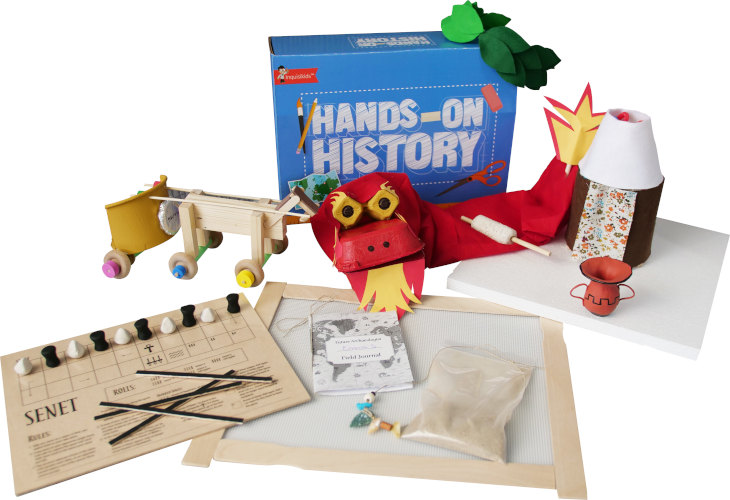The Hands-On History Kit: World History I has nine projects that tie in with ancient history. The kit was created by InquisiKids and can be used with any course covering ancient history for children in about first through third grade. Each student will need his or her own kit.
The kit has an 84-page, full-color instruction book and nine individual packets for the projects. The packets include just about everything you will need for each project aside from items such as scissors, markers, a ruler, a baking sheet, and parchment paper. A few pages at the back of the instruction book serve as templates for parts of a couple of the projects. The project packets in this kit are:
- Clay cylinder seal (ancient Sumer)
- Senet board game (ancient Egypt)
- Archaeology kit for making a sifting screen, a field journal, and a necklace (constructed from “found artifacts” which are included in the kit)
- Dragon puppet (ancient China)
- Laurel wreath (ancient Greece)
- Greek vase (ancient Greece)
- Trojan horse (ancient Greece and Troy)
- Chariot (ancient Rome)
- Miniature yurt (nomadic peoples of Asia)
This is an arts-and-crafts kit rather than a resource for teaching fine art skills. Even so, children will pick up some art skills as they work with the different media and materials.
The difficulty of each project is rated on a scale 1 (easy) to 3 (challenging). Projects are also rated as to the amount of parent time required on a scale of 1 (less time) to 3 (more time). For example, the clay cylinder seal is rated at 1 for both difficulty and parent time required—easy enough for first graders and great for children with short attention spans. The Trojan horse project is also rated at 1 in both categories, although it requires some measurement and marking that seems more challenging than the work required for the clay cylinder. On the other extreme are the dragon puppet and the miniature yurt, both of which are rated 3 for both difficulty and parent time required. All of the other projects lie somewhere in between.
The step-by-step directions in the instruction book include plenty of pictures, so both parent and child can see what they should be doing. A couple of the projects allow students to individualize their results. For instance, children can use a felt-tip marker to decorate their Greek vase, and the plain wood of the Trojan horse might be painted or decorated in some fashion, although you’re on your own to decide whether to use paint, markers, yarn, or other resources.
Some of the kit materials are more substantial and sturdy than are those in other craft kits for young children. For instance, the Trojan horse is constructed from solid wood pieces, including the wheels.
The Hands-On History Kit: World History I is an easy way to add a hands-on dimension for history lessons for young students, and even better, some of the projects will be items children can play with or use after they are constructed.








